fuel cap Citroen BERLINGO MULTISPACE 2015 2.G Owner's Manual
[x] Cancel search | Manufacturer: CITROEN, Model Year: 2015, Model line: BERLINGO MULTISPACE, Model: Citroen BERLINGO MULTISPACE 2015 2.GPages: 298, PDF Size: 12.69 MB
Page 7 of 298
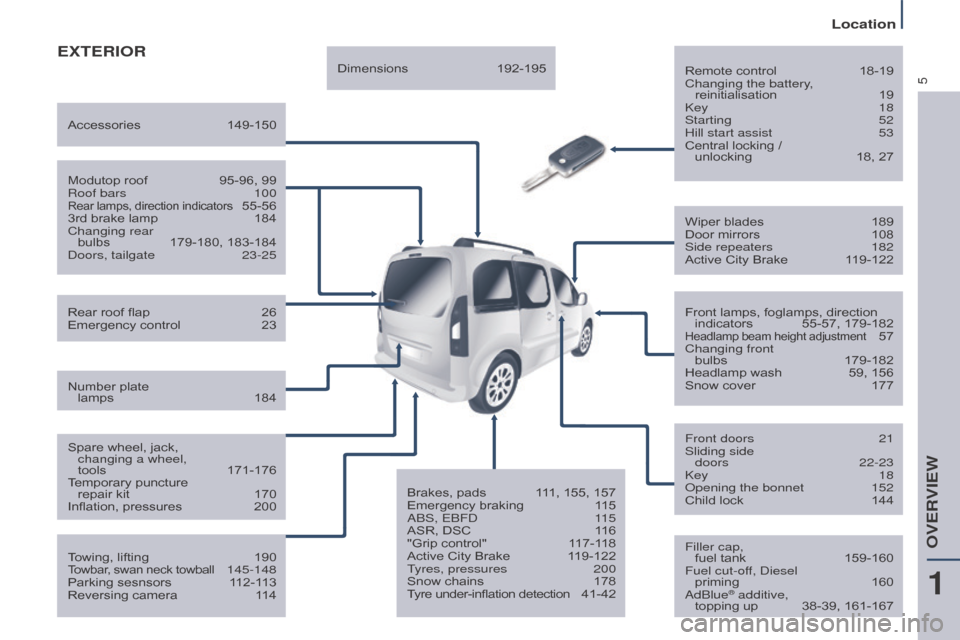
5
Berlingo-2-VP_en_Chap01_vue-ensemble_ed01-2015
ExTERIOR
Remote control 18-19
Changing the battery ,
reinitialisation
19k
ey
18
Starting
52
Hill start assist
53
Central
locking /
unlocking
18,
27
Filler cap, fuel
tank
159-160
Fuel cut-of
f, d iesel
priming
160a
dBlue
® additive,
topping up 38-39, 161-167
Wiper
blades
189
Door
mirrors
108
Side repeaters
182
Active
City Brake
1
19-122
Front
lamps, foglamps, direction
indicators
55-57,
179-182
Headlamp beam height adjustment 57
Changing front bulbs
179-182
Headlamp
wash
59,
156
Snow
cover
177
Front doors
21
Sliding side
doors
22-23k
ey
18o
pening the bonnet
152
Child
lock
144
T
owing,
lifting
190Towbar, swan neck towball 145-148
Parking
sesnsors
1 12-113
Reversing
camera
1
14
Rear
roof
flap
26
Emergency
control
23
Spare
wheel,
jack,
changing a wheel,
tools
171-176
T
emporary
puncture
repair
kit
170
Inflation,
pressures
200
Modutop
roof
95-96,
99
Roof bars
100Rear lamps, direction indicators 55-56
3rd
brake
lamp
184
Changing rear
bulbs
179-180,
183-184
d
oors, tailgate
23-25
Accessories
149-150
Dimensions
192-195
Brakes,
pads
1
11, 155, 157
Emergency
braking
1
15
a
BS, EBF d
1
15
ASR,
DSC
1
16
"Grip
control"
1
17-118
Active
City Brake
1
19-122
Tyres, pressures
200
Snow
chains
178
T
yre under-inflation detection
4
1-42
Number
plate
lamps
184
1
oVERVIEW
Location
Page 20 of 298
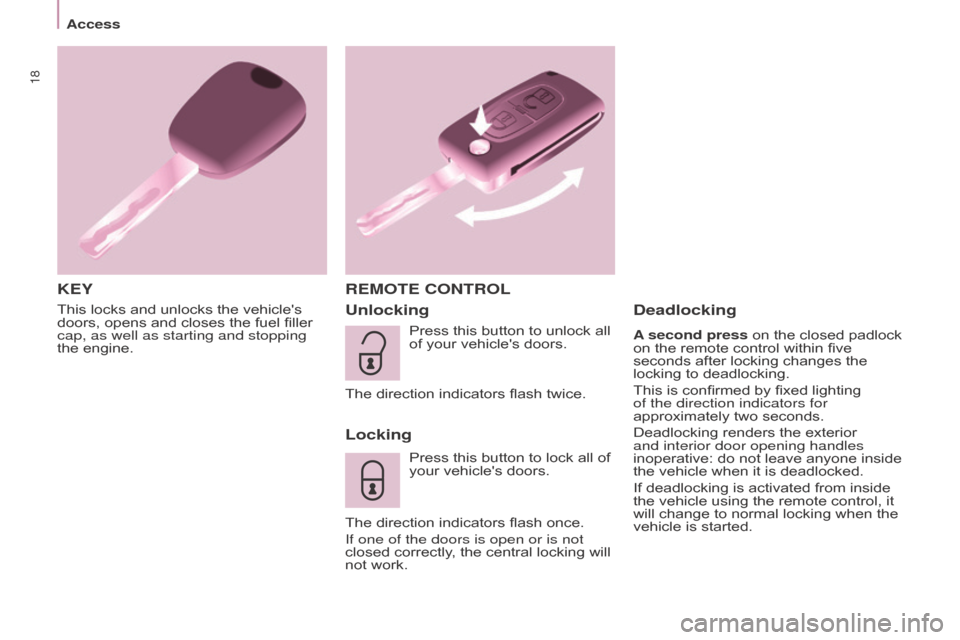
18
Berlingo-2-VP_en_Chap03_Pret-a-partir_ed01-2015
This locks and unlocks the vehicle's doors, opens and closes the fuel filler
cap, as well as starting and stopping
the
engine.
KEYR EMOTE CONTROL
Unlocking
Locking
Press this button to lock all of your
vehicle's doors.
The
direction indicators flash once.
If one of the doors is open or is not
closed
correctly, the central locking will
not
work.
Deadlocking
A second press on the closed padlock on the remote control within five
seconds
after locking changes the
locking
to deadlocking.
This
is confirmed by fixed lighting
of the direction indicators for
approximately
two seconds.
Deadlocking
renders the exterior
and interior door opening handles
inoperative:
do not leave anyone inside
the
vehicle when it is deadlocked.
If
deadlocking is activated from inside
the
vehicle using the remote control, it
will
change to normal locking when the
vehicle
is started.
Press
this
button
to
unlock
all
of
your
vehicle's
doors.
The
direction
indicators
flash
twice.
access
Page 36 of 298
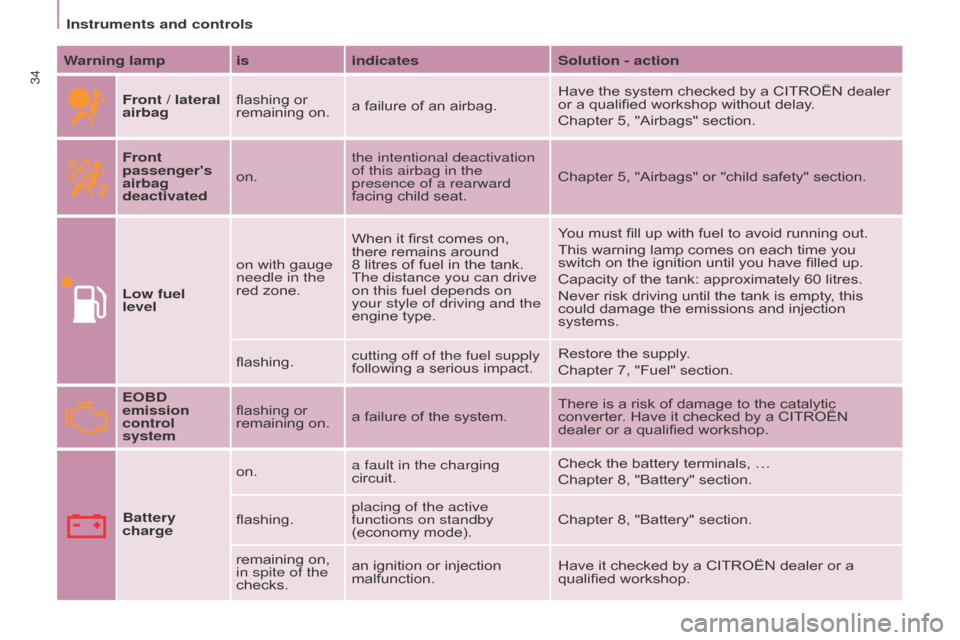
Berlingo-2-VP_en_Chap03_Pret-a-partir_ed01-2015
34
Warning lamp isindicatesSolution - action
Front / lateral
airbag flashing
or
remaining
on.a
failure of an airbag.Have
the system checked by a CITROËN dealer
or
a qualified workshop without delay.
Chapter
5, "Airbags" section.
Front
passenger's
airbag
deactivated on. the intentional deactivation
of this airbag in the
presence of a rearward
facing
child seat.Chapter
5, "Airbags" or "child safety" section.
Low fuel
level on with gauge
needle in the
red
zone.When
it first comes on,
there
remains around
8 litres
of fuel in the tank.
The distance you can drive
on this fuel depends on
your style of driving and the
engine
type.You
must fill up with fuel to avoid running out.
This
warning lamp comes on each time you
switch
on the ignition until you have filled up.
Capacity
of the tank: approximately 60 litres.
Never
risk driving until the tank is empty, this
could
damage the emissions and injection
systems.
flashing. cutting of
f of the fuel supply
following
a serious impact.Restore
the supply.
Chapter
7, "Fuel" section.
EOBD
emission
control
system flashing
or
remaining
on.a
failure of the system.There
is a risk of damage to the catalytic
converter
. Have it checked by a CITROËN
dealer
or a qualified workshop.
Battery
charge on.
a fault in the charging
circuit. Check
the battery terminals, …
Chapter
8, "Battery" section.
flashing. placing of the active
functions on standby
(economy
mode).Chapter
8, "Battery" section.
remaining
on,
in spite of the
checks.an
ignition or injection
malfunction.Have
it checked by a CITROËN dealer or a
qualified
workshop.
Instruments and controls
Page 42 of 298
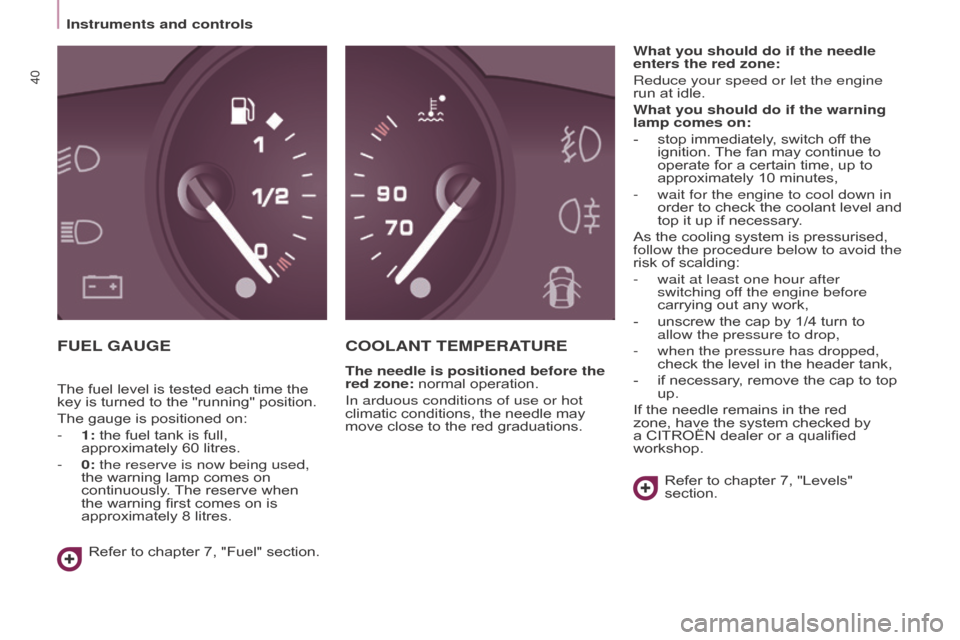
Berlingo-2-VP_en_Chap03_Pret-a-partir_ed01-2015
40
FUEL GAUGEC OOLANT TEMPERATURE
The needle is positioned before the
red zone:
normal operation.
In arduous conditions of use or hot
climatic
conditions, the needle may
move
close to the red graduations.What you should do if the needle
enters the red zone:
Reduce your speed or let the engine
run
at idle.
What you should do if the warning
lamp comes on:
-
stop
immediately, switch off the
ignition.
The
fan may continue to
operate
for a certain time, up to
approximately
10 minutes,
-
wait for the engine to cool down in
order
to check the coolant level and
top
it up if necessary.
As the cooling system is pressurised,
follow the procedure below to avoid the
risk
of scalding:
-
wait at least one hour after
switching of
f the engine before
carrying out any work,
-
unscrew
the cap by 1/4 turn to
allow the pressure to drop,
-
when the pressure has dropped,
check
the level in the header tank,
- if necessary, remove the cap to top
up.
If
the needle remains in the red
zone,
have the system checked by
a
CITROËN dealer or a qualified
workshop.Refer
to chapter 7, "Levels"
section.
Refer
to
chapter
7,
"Fuel"
section.
The
fuel
level
is
tested
each
time
the
key
is
turned
to
the
"running"
position.
The
gauge
is
positioned
on:
-
1:
the
fuel
tank
is
full,
approximately
60
litres.
-
0:
the reserve is now being used,
the
warning
lamp
comes
on
continuously
.
The
reserve
when
the
warning
first
comes
on
is
approximately
8
litres.
Instruments and controls
Page 161 of 298
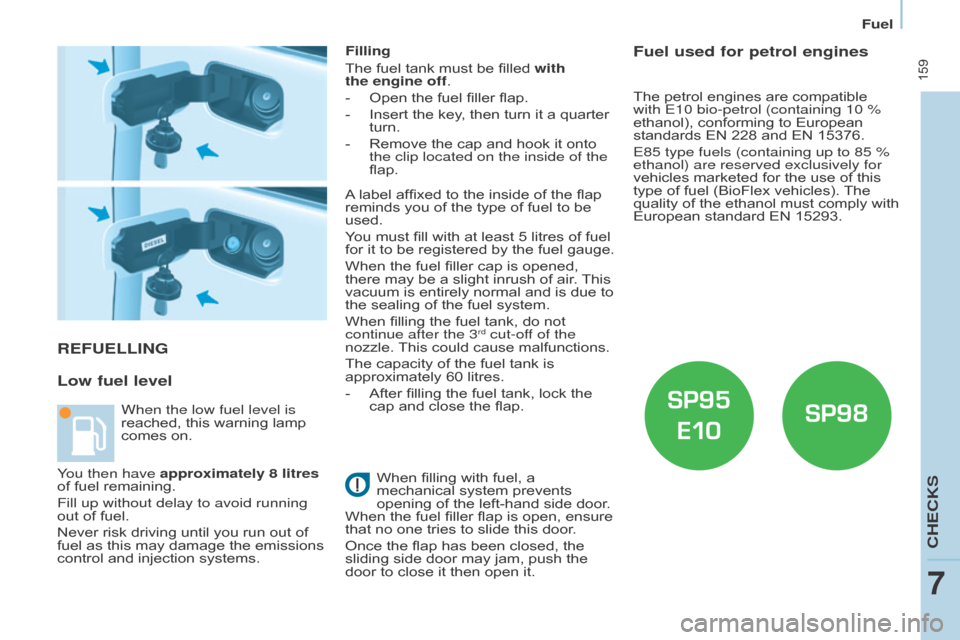
159
Berlingo-2-VP_en_Chap07_Verification_ed01-2015Berlingo-2-VP_en_Chap07_Verification_ed01-2015
REFUELLING
Low fuel level
Filling
The fuel tank must be filled with
the
engine off.
-
Open
the fuel filler flap.
-
Insert
the key, then turn it a quarter
turn.
-
Remove
the cap and hook it onto
the clip located on the inside of the
flap.
When
filling with fuel, a
mechanical
system prevents
opening
of the left-hand side door.
When
the fuel filler flap is open, ensure
that
no one tries to slide this door.
Once
the flap has been closed, the
sliding
side door may jam, push the
door
to close it then open it.
When the low fuel level is
reached,
this
warning
lamp
comes
on. A
label affixed to the inside of the flap
reminds
you of the type of fuel to be
used.
Y
ou must fill with at least 5 litres of fuel
for
it to be registered by the fuel gauge.
When
the fuel filler cap is opened,
there
may be a slight inrush of air.
This
vacuum
is entirely normal and is due to
the
sealing of the fuel system.
When
filling the fuel tank, do not
continue after the 3rd cut-off of the
nozzle.
This
could
cause malfunctions.
The
capacity
of
the
fuel tank is
approximately
60
litres.
-
After
filling
the
fuel tank, lock the
cap
and
close
the flap.
Fuel used for petrol engines
The petrol engines are compatible with E10 bio-petrol (containing 10 %
ethanol), conforming to European
standards
EN 228 and EN 15376.
E85 type fuels (containing up to 85 %
ethanol) are reserved exclusively for
vehicles
marketed for the use of this
type
of fuel (BioFlex vehicles).
The
quality
of the ethanol must comply with
European
standard EN 15293.
You then have approximately 8 litres
of
fuel
remaining.
Fill up without delay to avoid running
out
of
fuel.
Never
risk
driving
until
you
run
out
of
fuel
as
this
may
damage
the
emissions
control
and
injection
systems.
CHECKS
7
Fuel
Page 163 of 298

161
Berlingo-2-VP_en_Chap07_Verification_ed01-2015Berlingo-2-VP_en_Chap07_Verification_ed01-2015
BLUEHDI
AND A D B LUE
® ADDITIVE
The technology
adBlue® is the brand name of the solution needed for operation of the
SCR
system. BlueHDI
vehicles have a specific
a dBlue
® additive tank with a capacity
of 17 litres .
It
has
an exterior filler with a blue filler
cap, located to the left of the
d iesel
fuel
filler cap.
Filling of the
a
dBlue
® tank can be done using 5 or 10 litre containers,
1.89
litre
bottles,
or
when at a fuel
fillin
g
station
equipped with a special
a
dBlue
® delivery pump for light vehicles.
The
objective
of
BlueHDi
is
to
reduce
by
up
to
90%
the
emissions
of
NOx
(nitrous oxides) in the air
, using a
system
that
converts
NOx
into
water
vapour and nitrogen in a dedicated
catalytic
converter:
SCR
(Selective
Catalytic
Reduction).
This
objective
meets
the
"Euro"
emissions
standard
adopted
by
the
European
Union
aimed
at
limiting
the
emissions
of
pollutants
from
internal
combustion
engines.
The BlueH
d
i generation of engines
allow
the
"Euro
6"
European
standard
to
be
met,
with
an
extra
tank
to
hold
the
a
dBlue
® fluid for the treatment of exhaust
gases.
This operation can also be carried
out by a CITR
o Ë n dealer or a
qualified
workshop.
Please note that the high delivery
pumps
at some filling stations,
intended only for lorries and coaches,
are not suitable for cars or light
commercial
vehicles.
Never
use these pumps.
CHECKS
7
AdBlue® additive
Page 198 of 298

196
Berlingo-2-VP_en_Chap09_Caract-technique_ed01-2015Berlingo-2-VP_en_Chap09_Caract-technique_ed01-2015
ENGINE CHARACTERISTICS
The engine characteristics (capacity,
maximum power, maximum power
speed,
fuel, CO2 emissions...) for your
vehicle are given in the registration
certificate.
These characteristics correspond
to the values type-approved
on a test bed, under conditions
defined
in European legislation
(Directive 1999/99/EC).
For
more information, refer to the
manufacturer's
website or sales
brochure
for the model. Contact
a
CITROËN dealer or a qualified
workshop.
WEIGHTS AND TOWED LOADS
These values, expressed in kg, can be found
on the manufacturer's VIN plate
or
label.
The
maximum weights and towed
loads for your vehicle can be found on
the
vehicle's registration certificate.
The
kerb weight is equal to the weight
without
load + driver (75 kg) + fuel tank
filled
to 90%.
The GTW and towed load values
indicated
are valid up to a maximum
altitude
of 1000 metres.
The
value of
the
towed load mentioned must be
reduced by 10 % for each additional
1000
metres.
With
load transfer, the braked trailer
weight can be increased, on condition
that the equivalent of this load is
removed
from the vehicle so that the
GTW
is not exceeded. High
ambient temperatures
may
result in a reduction in the
performance
of the vehicle in
order
to protect the engine. When the
ambient
temperature is higher than
37 °C,
limit the towed weight.
Towing with a lightly loaded
vehicle can adversely affect road
holding.
Towing
a trailer increases braking
distances.
When
towing, the maximum permitted
speed
is reduced (comply with the
legislation
in force in the country).
The
recommended nose weight is the downward force on the towball
(removable
with or without tools).
GVW: gross vehicle weight, the
maximum
authorised weight.
GTW:
gross train weight, the maximum
weight
for vehicle plus trailer.
The
location of the manufacturer's
plate
is given in chapter 9,
"Identification
markings" section.
In
each country, it is imperative that
the
maximum towed loads authorised
by
local legislation are complied
with.
T
o find out your vehicle's towing
capacities and its gross train weight,
consult
a CITROËN dealer.
Weights